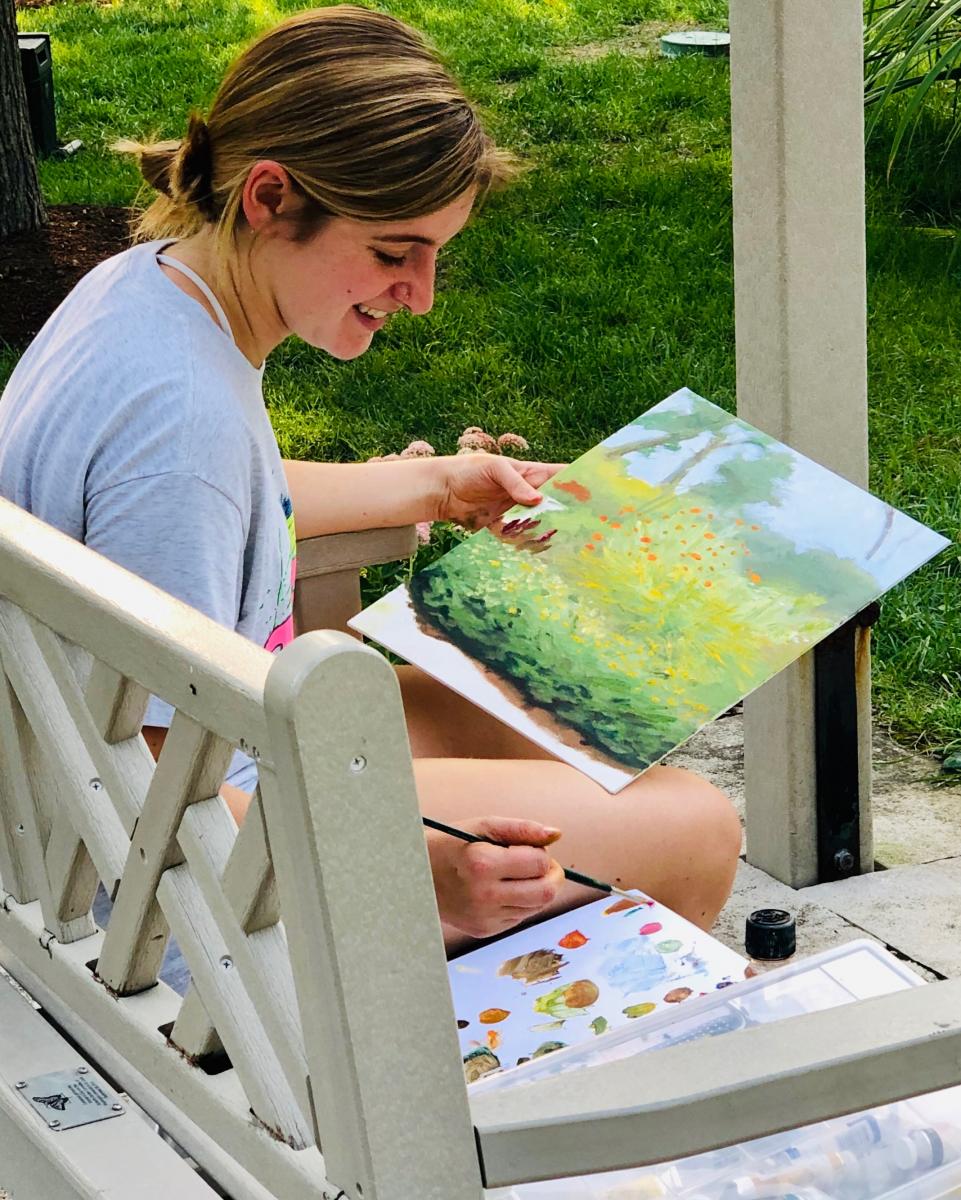In stressful times, finding pockets of nature wherever we can is a key way to cultivate mental well-being. Positive psychologist Tim Bono explains why and how we should connect with restorative natural havens like our campus’ Elizabeth Gray Danforth Butterfly Garden.
Despite the overwhelming uncertainty of recent weeks, nature offers one relief: Spring is emerging in the Northern Hemisphere. Flowers are blooming, trees are budding, and birds and butterflies are preparing for their spring migrations.
This relief is especially vital as an increasing number of people now live under shelter-in-place mandates requiring them to stay home except for essential activities. We will all be spending much less time outdoors than normal this spring. However, outdoor exercise is considered an essential activity, and an ever-increasing body of research has shown that nature offers important psychological benefits.

One major challenge to mental well-being comes from “positive-negative asymmetry,” the phenomenon that we tend to dwell on negative thoughts more than positive ones, according to Tim Bono, assistant dean, lecturer in Psychological & Brain Sciences, and instructor of a popular course on positive psychology. Nature, he says, provides an effective way to counter this negativity.
“When something is new, when it's novel, that attracts our attention much more so than things that are mundane or routine,” Bono explained. “The variety that nature provides seems to have a special ability to capture our attention and draw our attention to something beautiful, something new, which then is getting us to put aside depression and anxiety and instead focus on something that's peaceful and serene.”
Almost any green space offers some benefit, and the emergence of spring can be especially potent because the trees growing leaves, flowers starting to bud, and birds becoming more active augment the sense of novelty and beauty.
A second benefit of nature comes from direct sunlight. “When sunlight enters the visual system, it activates a neural circuit that is associated with motivation, alertness, and mood,” said Bono. Even when stuck indoors, students can harness this benefit by studying near a window with a view of nature.
In one 2013 experiment by Benfield et al., students in an introductory writing class were assigned at random to classrooms with windows offering a view of either blossoming trees or a concrete wall. At the end of the semester, students with the view of nature rated the class more positively and received higher grades on average than those with the view of a concrete wall.
Washington University has long recognized the importance of green spaces and incorporated them into the design of the campus. One such space, the Elizabeth Gray Danforth Butterfly Garden, is a rich resource that often goes unnoticed. Those who do visit the garden encounter a serene natural haven buzzing with life.
The butterfly garden was dedicated in 1996 in memory of Elizabeth Gray Danforth, the former first lady of the university. Since then, a team of volunteers from the university’s Woman’s Club has led the maintenance and growth of the garden, which now hosts over ninety native species of trees, shrubs, and flowers.
“It is meant to be a collection of plants that represents the diversity of the plants that are native to Missouri, and especially ones that attract butterflies,” said Lee Anne Quatrano, who has volunteered in the garden for the past twelve years. “The colors and the fragrances attract different butterflies at different stages throughout the spring and summer.” Each year, over a dozen butterfly species find a home here.
“Exposure to nature can really go a long way in improving our overall mood and cognitive abilities.”
Quatrano serves as co-chair of the team of volunteers for the garden. Although she did not attend WashU herself, she has strong ties to the university: Her husband, Ralph Quatrano, is a professor emeritus of biology, her daughter attended the School of Medicine, and three of her grandchildren have graduated from WashU.
Starting in March each year, volunteers from the Woman’s Club prepare the garden for the planting of annual flowers, and the butterfly season begins in earnest in May. Traditionally, the club plants all the new flowers in one “big dig,” but under the current circumstances, very small groups of volunteers will carry out the planting over several days. The WU Focal Pointe grounds crew, led by Chris Anderson, collaborates in the regular maintenance of the garden and will continue their involvement this year.
From July to September, the most populous butterfly species in the garden is the monarch, which passes through the Midwest as it migrates from Canada to Mexico. Climate change and habitat loss threaten global monarch populations, especially since the caterpillars can only eat milkweed plants. As a result, “monarch waystations” like the Danforth Butterfly Garden offer an important haven for monarchs. The garden features five species of milkweed, including native species.
Beyond choosing the plants that will attract butterflies, Quatrano and the other volunteers have thought holistically about the garden’s ecosystem. In recent years, the rabbit population has grown dramatically, making it hard to prevent rabbits from eating the plants meant for the butterflies. This February, the volunteers installed an owl nesting platform in a tree with the hope of attracting a great horned owl to keep the garden’s ecosystem in balance.

As part of their mission of service to the broader St. Louis community, the Woman’s Club invites classes from local schools to visit the garden and learn about ecology. “It’s important to have biodiversity and ecological balance in life, and we're trying to teach the students early to honor that and to appreciate it,” Quatrano said. “They're in there with their coloring pages and their science kits and they're taking their own pictures and their own notes in their journals, and it's really fun.”
One hands-on lesson last year came from pipevine swallowtails and monarchs, two butterflies whose caterpillars appear very similar. Quatrano showed the kids how to distinguish the two by noting that the pipevine swallowtail caterpillars feasted on parsley, while the monarch caterpillars dined on milkweed.
The design of the garden has long been welcoming to WashU students who want to relax as well as those who want to do homework while surrounded by nature.
Sophomore Sophie Devincenti, an educational studies major, chose the garden when she had to paint an outdoor scene at three times of day for an introductory painting class. “There were a lot of bright colors that attracted me,” Devincenti said. “I think it was the overflowing abundance of all the flowers. It was beautiful to see this composition of the path, the flowers, layers of trees, and the sky behind.”
Until we can return to campus, Bono encourages members of the university community to find a pocket of nature close to our homes and incorporate it into our routines. He says that taking a walk outside, especially when faced with stress and anxiety, is one of the best things we can do for ourselves.
“Just remind yourself of opportunities to increase your exposure to nature, especially on days that are sunny. Exposure to nature can really go a long way in improving our overall mood and cognitive abilities.”




